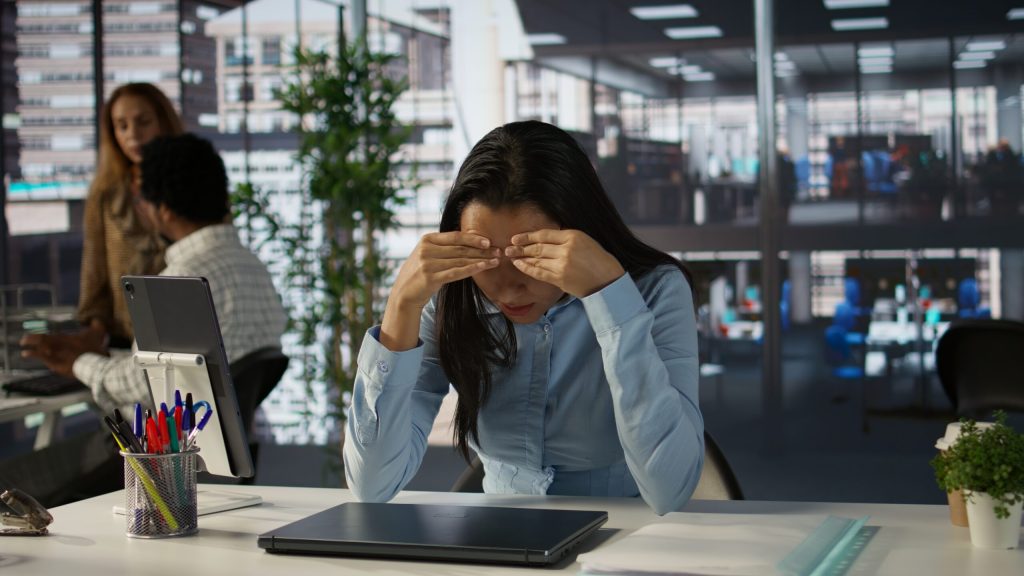5 Hidden Signs of Burnout in High-Performing People

The hidden burnout signs in high performers often go unnoticed because these individuals push themselves to excel, masking symptoms until they become severe. Burnout is a serious condition that affects mental, emotional, and physical health, especially among high-achieving people who set high standards and work relentlessly. This article explores five subtle but powerful signs of burnout in high performers, supported by case studies, expert advice, and practical tips to help you or someone you know recognize and address burnout early.
What Is Burnout in High-Performing People?
Burnout is a state of emotional, physical, and mental exhaustion caused by prolonged stress and overwork. High performers often face intense pressure to maintain success, which can lead to hidden burnout signs that are easy to overlook.

Hidden Burnout Signs in High Performers
1. Chronic Exhaustion Despite Adequate Rest
One of the most common hidden burnout signs in high performers is feeling constantly tired, even after getting enough sleep. This exhaustion is more than just fatigue; it’s a deep depletion of energy that rest alone cannot fix.
Case Study:
Jessica, a top sales executive, began feeling drained despite sleeping 7-8 hours nightly. She pushed through her workdays but noticed her energy levels never fully recovered, signaling early burnout.
2. Increased Cynicism and Detachment
High performers may develop a negative attitude toward their work or colleagues, which is a subtle burnout sign. This cynicism often masks deeper feelings of frustration and helplessness.
Case Study:
Mark, a high-level manager, started distancing himself from his team and expressing sarcastic remarks. His usual passion for projects faded, showing emotional detachment linked to burnout.
3. Reduced Productivity and Creativity
Burnout can cause a decline in work quality and innovation. High performers who once thrived on challenges may find themselves struggling to focus or generate new ideas.
Case Study:
Samantha, a creative director, noticed her ideas became repetitive and her motivation dropped. Her productivity declined, a hidden burnout sign that alarmed her to seek help.
4. Physical Symptoms Without Medical Cause
Burnout often manifests physically through headaches, muscle pain, or digestive issues without an identifiable medical reason.
Case Study:
David, a software engineer, experienced frequent migraines and stomach aches. Medical tests were normal, but his symptoms improved only after addressing work-related stress.
5. Neglecting Personal Needs and Relationships
High performers may sacrifice self-care and social connections to meet demands, a critical but hidden burnout sign.
Case Study:
Emily, a lawyer, stopped exercising and avoided friends. Her isolation and neglect of personal needs were early indicators of burnout.
Comparing Hidden Burnout Signs vs. Common Stress Symptoms
| Symptom | Hidden Burnout Signs in High Performers | Common Stress Symptoms |
|---|---|---|
| Exhaustion | Chronic, persistent despite rest | Temporary, relieved by rest |
| Attitude | Cynicism, detachment | Irritability, anxiety |
| Productivity | Decline in creativity and work quality | Fluctuations without lasting impact |
| Physical Symptoms | Unexplained headaches, pain | Muscle tension, occasional discomfort |
| Social Behavior | Withdrawal, neglect of relationships | Social irritability, mood swings |
Why High Performers Are More Vulnerable to Burnout
High performers often set extremely high expectations for themselves, work long hours, and struggle to delegate tasks. Their drive for perfection and fear of failure can prevent them from recognizing or admitting burnout.
How to Prevent and Manage Burnout in High Performers
- Prioritize self-care: Regular sleep, healthy eating, and exercise.
- Set boundaries: Learn to say no and delegate tasks.
- Seek support: Talk to trusted friends, mentors, or mental health professionals.
- Practice mindfulness: Techniques like meditation can reduce stress.
- Schedule breaks: Regular downtime to recharge mentally and physically.
The Role of Workplace Culture in Burnout
Workplaces that demand constant availability and reward overwork contribute heavily to burnout in high performers. Creating a supportive environment with realistic expectations is crucial.
Case Study – Corporate Culture and Burnout
A 2024 survey showed that 70% of high-performing employees in a tech firm reported burnout symptoms linked to 24/7 availability expectations.
The Importance of Early Detection
Recognizing hidden burnout signs in high performers early can prevent severe consequences like depression, anxiety, and chronic health problems.
When to Seek Professional Help
If burnout symptoms persist despite lifestyle changes, consulting a healthcare professional or therapist is essential for recovery.
The Psychological Impact of Burnout on High Performers
Burnout doesn’t just affect physical health and productivity; it also deeply impacts mental and emotional well-being. High performers often tie their self-worth to their achievements, so burnout can lead to feelings of inadequacy, guilt, and low self-esteem.
Emotional Exhaustion and Identity Crisis
Many high achievers experience emotional exhaustion, where they feel drained and unable to cope emotionally. This can trigger an identity crisis, as their sense of self is closely linked to success and performance. When burnout strikes, they may question their purpose and value beyond their work.
Case Study: Identity Loss in Burnout
Anna, a top consultant, described feeling “lost” and disconnected from her usual confident self during burnout. She struggled to find motivation and feared she would never perform at her previous level.
The Role of Perfectionism in Hidden Burnout Signs
Perfectionism is a common trait among high-performing people and a major contributor to burnout. The constant pressure to be flawless can lead to chronic stress and exhaustion.

How Perfectionism Drives Burnout
- Setting unrealistic goals that are hard to achieve.
- Fear of failure causing overwork and avoidance of delegation.
- Self-criticism and harsh judgment when things don’t go perfectly.
Overcoming Perfectionism to Reduce Burnout
Learning to accept imperfection and focusing on progress rather than perfection can significantly reduce burnout risk.
Burnout’s Effect on Decision-Making and Risk-Taking
Hidden burnout signs include impaired cognitive function. High performers may notice difficulty making decisions, increased indecisiveness, or risk aversion.
Cognitive Fatigue and Its Consequences
Burnout causes mental fatigue, reducing attention, memory, and problem-solving skills. This can lead to mistakes, missed opportunities, and decreased confidence in leadership roles.
Case Study: Decision-Making Decline
James, a senior executive, reported feeling overwhelmed by routine decisions and avoiding challenging projects during his burnout phase, which affected his team’s performance.
Burnout and Sleep Disturbances in High Performers
Sleep problems are often overlooked but are a critical hidden burnout sign. High performers may experience insomnia, restless sleep, or frequent waking, which worsens exhaustion and cognitive issues.
Why Burnout Disrupts Sleep
Stress hormones like cortisol remain elevated during burnout, interfering with the body’s natural sleep-wake cycle. Poor sleep quality then exacerbates burnout symptoms in a vicious cycle.
Tips for Improving Sleep During Burnout
- Establish a consistent bedtime routine.
- Avoid screens and caffeine before sleep.
- Practice relaxation techniques like deep breathing or progressive muscle relaxation.
The Impact of Burnout on Personal Relationships
Burnout doesn’t only affect work life; it also strains personal relationships. High performers may withdraw from family and friends or become irritable and emotionally unavailable.
Relationship Strain and Social Withdrawal
The neglect of social connections is a hidden burnout sign that can lead to loneliness and decreased emotional support, which are vital for recovery.
Case Study: Relationship Challenges
Laura, a high-achieving entrepreneur, noticed growing distance between her and her partner during burnout. She realized that addressing burnout was essential to repairing their relationship.
Strategies for Organizations to Support High Performers and Prevent Burnout

Preventing burnout requires systemic changes in workplace culture and policies. Organizations play a crucial role in supporting high performers.
Effective Organizational Practices
- Promote realistic workloads and flexible schedules.
- Encourage regular breaks and time off.
- Provide mental health resources and counseling.
- Foster a culture that values well-being over constant productivity.
- Train managers to recognize burnout signs and support employees.
Case Study: Corporate Burnout Prevention Program
A 2025 case study of a multinational company showed a 30% reduction in burnout rates after implementing flexible work hours and wellness programs focused on mental health.
Long-Term Consequences of Ignoring Burnout
Ignoring hidden burnout signs can lead to severe long-term consequences, including chronic health problems, depression, and career derailment.
Health Risks Associated with Burnout
- Increased risk of cardiovascular disease.
- Weakened immune system.
- Higher likelihood of anxiety and depression.
- Potential for substance abuse as a coping mechanism.
Career Impact
Burnout can cause decreased job satisfaction, increased absenteeism, and ultimately, career burnout or job loss.
Building Resilience to Combat Burnout
Resilience is the ability to bounce back from stress and adversity. Building resilience is key to managing and preventing burnout.
Ways to Build Resilience
- Develop strong social support networks.
- Practice mindfulness and stress management techniques.
- Maintain a balanced lifestyle including hobbies and relaxation.
- Cultivate a growth mindset to view challenges as opportunities.
The Link Between Burnout and Physical Health Decline in High Performers
Burnout doesn’t only affect mental and emotional well-being—it can significantly impact physical health. High performers often ignore early physical warning signs, which can lead to serious health issues over time.
Common Physical Health Issues Related to Burnout
- Cardiovascular problems: Chronic stress from burnout elevates blood pressure and heart rate, increasing the risk of heart disease.
- Gastrointestinal issues: Stress can cause stomach pain, acid reflux, or irritable bowel syndrome.
- Weakened immune system: Burnout reduces the body’s ability to fight infections, leading to frequent illnesses.
- Chronic pain: Muscle tension and headaches are common physical symptoms.
Case Study: Burnout Leading to Health Complications
Michael, a high-performing lawyer, ignored chronic headaches and fatigue until he suffered a mild heart attack. His doctors linked his condition to prolonged burnout and stress.
The Role of Emotional Intelligence in Recognizing Burnout
Emotional intelligence (EI) plays a critical role in identifying and managing burnout. High performers with strong EI are better equipped to notice early burnout signs in themselves and others.
How Emotional Intelligence Helps
- Self-awareness: Recognizing feelings of exhaustion or detachment early.
- Self-regulation: Managing stress responses and setting healthy boundaries.
- Empathy: Understanding burnout signs in colleagues and offering support.
- Social skills: Building supportive networks that buffer against burnout.
Developing Emotional Intelligence
Practicing mindfulness, seeking feedback, and engaging in reflective journaling can enhance EI and help prevent burnout.
The Impact of Remote Work on Burnout in High Performers

The rise of remote work has blurred the boundaries between professional and personal life, creating new challenges for high performers prone to burnout.
Remote Work Burnout Triggers
- Longer working hours: Without clear boundaries, many work beyond traditional hours.
- Isolation: Lack of social interaction can increase feelings of loneliness and stress.
- Distractions and multitasking: Home environments may reduce focus and increase fatigue.
- Technology overload: Constant connectivity leads to digital burnout.
Strategies to Combat Remote Work Burnout
- Establish a dedicated workspace.
- Set strict start and end times for work.
- Schedule regular breaks and social interactions.
- Use technology mindfully, limiting notifications and screen time.
Gender Differences in Burnout Among High Performers
Burnout affects men and women differently, influenced by societal expectations, work roles, and coping mechanisms.
How Burnout Manifests Differently
- Women: Often experience emotional exhaustion and may juggle work with caregiving roles, increasing stress. They may also face workplace discrimination and microaggressions.
- Men: May show more depersonalization or withdrawal and are less likely to seek help due to stigma around mental health.
Tailoring Burnout Interventions by Gender
Understanding these differences can help design more effective support systems and workplace policies.
The Importance of Nutrition and Hydration in Managing Burnout
Physical self-care, including proper nutrition and hydration, is often overlooked but essential in managing burnout symptoms.
How Nutrition Affects Burnout
- Balanced diets support brain function and energy levels.
- Deficiencies in vitamins like B12, D, and magnesium can worsen fatigue and mood.
- Avoiding excessive caffeine and sugar prevents energy crashes.
Hydration and Mental Clarity
Dehydration can impair concentration and increase irritability, compounding burnout symptoms.
Practical Tips
- Eat regular, nutrient-rich meals.
- Drink plenty of water throughout the day.
- Limit processed foods and stimulants.
The Role of Mindfulness and Meditation in Preventing Burnout
Mindfulness and meditation are powerful tools to reduce stress and build resilience against burnout.
Benefits of Mindfulness for High Performers
- Enhances focus and emotional regulation.
- Reduces rumination and anxiety.
- Improves sleep quality and overall well-being.
Getting Started with Mindfulness
- Begin with short daily sessions (5-10 minutes).
- Use guided meditation apps or attend classes.
- Incorporate mindful breathing during stressful moments.
Building a Support System: Why High Performers Shouldn’t Go It Alone
High performers often try to handle stress independently, but building a strong support system is vital for burnout prevention and recovery.
Types of Support
- Professional: Therapists, coaches, or counselors.
- Social: Friends, family, and peer groups.
- Workplace: Mentors, managers, and employee assistance programs.
Benefits of Support
- Provides emotional relief and perspective.
- Encourages accountability for self-care.
- Offers practical help and resources.
Conclusion
The hidden burnout signs in high performers are subtle but serious. Being aware of these signs can help individuals take proactive steps to protect their health and maintain long-term success. Remember, true high performance comes with balance, not burnout.





